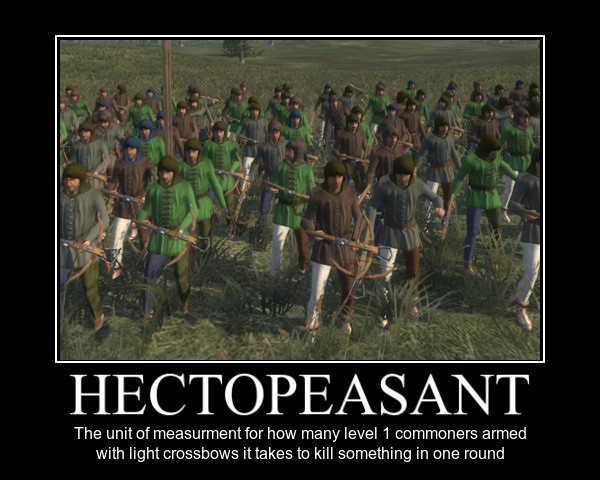Hectopeasant: Difference between revisions
No edit summary |
No edit summary |
||
| Line 1: | Line 1: | ||
[[File:HectoPeasant2.jpg]] | |||
A unit of measurement devised for the purpose of describing a creature's durability. The hectoPeasant value of a given creature is how many hundreds of peasants are required to kill it in a single volley of ranged attacks, accounting for accuracy and average damage. | A unit of measurement devised for the purpose of describing a creature's durability. The hectoPeasant value of a given creature is how many hundreds of peasants are required to kill it in a single volley of ranged attacks, accounting for accuracy and average damage. | ||
Revision as of 21:34, 5 August 2014
 A unit of measurement devised for the purpose of describing a creature's durability. The hectoPeasant value of a given creature is how many hundreds of peasants are required to kill it in a single volley of ranged attacks, accounting for accuracy and average damage.
A unit of measurement devised for the purpose of describing a creature's durability. The hectoPeasant value of a given creature is how many hundreds of peasants are required to kill it in a single volley of ranged attacks, accounting for accuracy and average damage.
HectoPeasant calculations can vary greatly from system to system, with some creatures being completely invulnerable to massed peasant attacks. This can have several root causes, from a general incompetence of the peasantry to extreme toughness or immunities of the creature. A creature that is immune to physical attacks in a system where peasants are only capable of dealing physical damage will have an infinite Hectopeasant value.
Methods
In systems with hit points (or an analogous numerical track from "fully healthy, fresh & rested" to "dead") you divide the hit points of the creature by the product of the odds of an individual peasant striking the creature and the average damage dealt by the peasant with the best ranged weapon he can wield in those rules. The quotient is the number of peasants required. Divide by 100 to get the hectopeasant value.
For Dungeons & Dragons 5th edition, this is (Hit Points / (((21 - Armor Class) +2) * 0.05) * 4.5 + 0.05 * 4.5)) * 100. This accounts for hit points, armor class, the peasants' weapon proficiency, average damage for a Light Crossbow, and average critical hit damage for the Light Crossbow.
note: Creatures with resistance to piercing weapons take only half damage, so the final product would be doubled.
also note: Creatures with an Armor Class above 22 are still hit on a natural die result of 20. If ((21 - Armor Class) + 2) is less than one, treat it as one anyway.
Alternate Use
The hectoPeasant can also be used to describe a character's ability to deal damage. Calculate the hectoPeasant value of a given opponent, then substitute the character's own attack bonus and average damage. Compare the two.
Practicality
The hectoPeasant is not meant to be a practical option in actual game play. The issues that arise from getting a hundred commoners formed up and armed with light crossbows in such a way as to actually let them all attack a target are beyond the scope of the hectoPeasant standard, and should be treated as a normal adventuring opportunity.